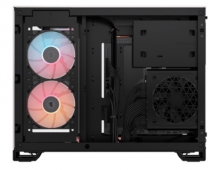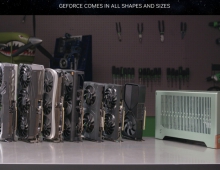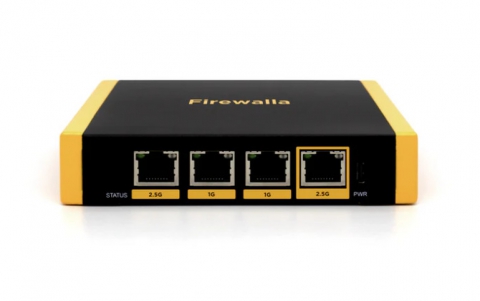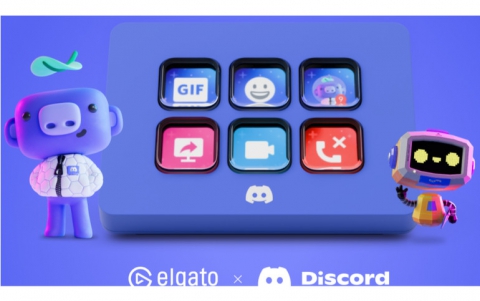
NVIDIA Modernizes Gaming With Cloud Technologies, New Tegra 4-powered Portable Gaming Device
In the first big announcement of this year's Consumer
Electronics Show, NVIDIA announced Tegra 4, a new
portable gaming device along with cloud gaming
technologies.
 Nvidia CEO Jen-Hsun Huang introduced the company's
first-ever gaming portable, called 'Project SHIELD,'
and a set of cloud technologies that delivers games
where and when you want them. He also unveiled the
fourth-generation of NVIDIA's Tegra mobile processor,
loaded with graphics capability.
Nvidia CEO Jen-Hsun Huang introduced the company's
first-ever gaming portable, called 'Project SHIELD,'
and a set of cloud technologies that delivers games
where and when you want them. He also unveiled the
fourth-generation of NVIDIA's Tegra mobile processor,
loaded with graphics capability.
Project SHIELD, a gaming portable for open platforms, is fitting in the hand. The device is equipped with a controller, a 1280x720 HD retinal multitouch display, with 294 dpi and audio that according to Nvidia "blows out high-end laptops."
The game controller features 2 concave thumbsticks, a 360-like D-pad , 4 face buttons, and 4 shoulder triggers/buttons (2 on each side). Powering the device will be 38 watt-hours of Lithium-Ion battery cells.
On the back side of the handheld are a micro-HDMI for display output (4K resolution supported), micro-USB for data connectivity, and a standard 3.5": audio jack for headphones.
Project SHIELD can be used to play on its own integrated screen or on a big screen, and on the couch or on the go.
As an Android device, it plays titles from Google's Play store, but has been also designed to allow users play both Android and Windows games,
Finally, on the software side of things NVIDIA is also going to be offering a level of integration between Project Shield and their GeForce products. By leveraging the Video Codec Engine video encoder inside their recent GTX 600 video cards, Project Shield devices will be able to connect to PCs to do remote gaming.
However, the Shield is targeting enthusiasts from the outset, if only because of its hefty system requirements. That streaming option requires host computers to pack Nvidia's latest and greatest graphics card, the GTX 650 (or the GTX 660M on laptops). Additional minimum specifications call for an Intel i5 chip, Windows 7, and 4GB of memory.
Project SHIELD can also access Android apps such as Hulu, Netflix and Slacker Radio.
Android-optimized titles are available on NVIDIA's TegraZone store. And gamers can access PC titles from their STEAM catalogue.
"Project SHIELD was created by NVIDIA engineers who love to game and imagined a new way to play," said Jen-Hsun Huang, co-founder and chief executive officer at NVIDIA. "We were inspired by a vision that the rise of mobile and cloud technologies will free us from our boxes, letting us game anywhere, on any screen. We imagined a device that would do for games what the iPod and Kindle have done for music and books, letting us play in a cool new way. We hope other gamers love SHIELD as much as we do."
Shield will launch in Q2 but Nvidia did not provide any pricing details - the company said the price would be "competitive with other mobile gaming systems and tablets."
The muscle for Project SHIELD is Tegra 4, which Jen-Hsun introduced as the world's most powerful mobile processor.
Previously codenamed "Wayne," Tegra 4 is built on TSMC's 28nm HPL (28nm low power with high-k + metal gates) and features 72 custom NVIDIA GeForce GPU cores -- or six times the GPU horsepower of Tegra 3. It includes the first quad-core application of ARM's most advanced CPU core, the Cortex-A15, which is clocked at 1.9GHz max and promises to deliver 2.6x faster web browsing and high performance for apps.

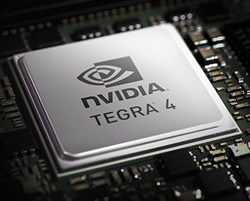 The fifth/companion core is also a Cortex A15, but synthesized to run at lower frequencies/voltages/power.
This extra core isn't visible to the OS, it's not big.LITTLE but it'll work similarly to how Tegra 3 worked.
The fifth/companion core is also a Cortex A15, but synthesized to run at lower frequencies/voltages/power.
This extra core isn't visible to the OS, it's not big.LITTLE but it'll work similarly to how Tegra 3 worked.
Tegra 4 also enables worldwide 4G LTE voice and data support through an optional chipset, the fifth-generation NVIDIA Icera i500 processor.
The processor is built on TSMC's 28nm HP (High Performance) High-K Metal Gate process. NVIDIA claims the i500 is more efficient and 40 percent the size of conventional modems and that it delivers four times the processing capability of its predecessor. The i500 can also actively power gate each of the individual 8 processing cores inside as load conditions change or depending on the software package loaded onto the modem.
NVIDIA's i500 will launch with LTE UE Category 3 (100Mbps downlink) support. A later release will enable UE Category 4 LTE.
"Tegra 4 provides enormous processing power and efficiency to power smartphones and tablets, gaming devices, auto systems and PCs," said Phil Carmack, senior vice president of the Tegra business at NVIDIA. "Its new capabilities, particularly in the area of computational photography, will help improve a whole range of existing products and lead to the creation of exciting new ones."
Among the Tegra 4 processor's breakthroughs is its Computational Photography Architecture, which automatically delivers high dynamic range (HDR) photos and video by fusing together the processing power of the GPU, CPU and the camera's image-signal processor.
Its HDR capability captures images, including those taken with a flash, the way they are seen by the human eye -- with detail in both bright and dark areas.
Designed for maximum energy efficiency, Tegra 4 includes a second-generation battery saver core for low power during standard use, and PRISM 2 Display technology to reduce backlight power.
Nvidia claims that Tegra 4 consumes up to 45 percent less power than its predecessor, Tegra 3, in common use cases. And it enables up to 14 hours of HD video playback on phones.
Tegra 4 Key Features
- GeForce GPU with 72 custom cores
- Quad-core ARM Cortex-A15 CPU, plus a 2nd Generation Battery Saver Core
- Computational Photography Architecture
- LTE capability with optional Icera i500 chipset
- 4K ultra-high-def video support
Jen-Hsun also gave an update on NVIDIA's strategy to snap the leash, by enabling this heavy lifting to be done in the cloud and then streamed instantly to the consumer. He said that half dozen pioneering companies are preparing to use it to deliver gaming services to broadband companies around the globe.
They'll doing so by deploying the NVIDIA GRID Cloud Gaming Platform to offer the interactivity of high-performance PC gaming on any connected screen. As a server with specialized hardware and streaming and virtualization software, it promises to simultaneously deliver up to 36-times more HD-quality game streams than first-gen cloud-gaming systems. And it does so while reducing lag.
The NVIDIA GRID Platform enables the seamless interactive experience of a high-performance gaming PC anywhere, on any screen -- including smart TVs, PCs, tablets and smartphones.
NVIDIA GRID is a server designed to concurrently serve up to 36 times more HD-quality game streams than first-generation cloud-gaming systems, while reducing lag. It is fully integrated with a high density of NVIDIA GPUs, specialized graphics-application streaming software and NVIDIA VGX Hypervisor technology, which allows multiple users to share a GPU.
Nvidia's initial partners on the NVIDIA GRID Platform include Agawi (United States); Cloud Union (China); Cyber Cloud Technologies (China); G-cluster Global (Japan); Playcast Media Systems (Israel); and Ubitus (Taiwan). "By using the NVIDIA GRID Platform, our partners will allow gamers to play anywhere, anytime, without being tethered to a box," said Phil Eisler, general manager of cloud gaming at NVIDIA. "The world's most exciting games can now be played as easily as you can stream a movie, right onto your TV or mobile device. No more discs to shuffle or files to download and install. Just click and play."
The NVIDIA GRID Platform is moving high-end gaming to the cloud, eliminating the need for users to manage game discs or fit game consoles next to flat-screen TVs.
 According to Nvidia, the GRID Platform delivers three key attributes:
According to Nvidia, the GRID Platform delivers three key attributes:
- It provides the highest number of concurrent, interactive data streams by using multi-GPU servers and sophisticated NVIDIA VGX GPU-sharing technology. Each server can deliver up to 36 game streams.
- The software and drivers enable interactive streaming of the widest range of games -- from casual games using low-graphics capabilities with a high density of streams, to high-performance titles requiring high-graphics capabilities.
- It delivers streamed content for seamless interaction without noticeable lag or latency. Nvidia claims that the GRID technology reduces game server latency by up to 30 milliseconds compared to prior solutions, which effectively hides the network delivery time.
At a CES event this week, NVIDIA will demonstrate the NVIDIA GRID Platform streaming games to an LG 55LA6900 Smart TV at 1080p resolution. Among the high-performance games that will be shown are "Assassin's Creed III" by Ubisoft.
 Nvidia CEO Jen-Hsun Huang introduced the company's
first-ever gaming portable, called 'Project SHIELD,'
and a set of cloud technologies that delivers games
where and when you want them. He also unveiled the
fourth-generation of NVIDIA's Tegra mobile processor,
loaded with graphics capability.
Nvidia CEO Jen-Hsun Huang introduced the company's
first-ever gaming portable, called 'Project SHIELD,'
and a set of cloud technologies that delivers games
where and when you want them. He also unveiled the
fourth-generation of NVIDIA's Tegra mobile processor,
loaded with graphics capability.
Project SHIELD, a gaming portable for open platforms, is fitting in the hand. The device is equipped with a controller, a 1280x720 HD retinal multitouch display, with 294 dpi and audio that according to Nvidia "blows out high-end laptops."
The game controller features 2 concave thumbsticks, a 360-like D-pad , 4 face buttons, and 4 shoulder triggers/buttons (2 on each side). Powering the device will be 38 watt-hours of Lithium-Ion battery cells.
On the back side of the handheld are a micro-HDMI for display output (4K resolution supported), micro-USB for data connectivity, and a standard 3.5": audio jack for headphones.
Project SHIELD can be used to play on its own integrated screen or on a big screen, and on the couch or on the go.
As an Android device, it plays titles from Google's Play store, but has been also designed to allow users play both Android and Windows games,
Finally, on the software side of things NVIDIA is also going to be offering a level of integration between Project Shield and their GeForce products. By leveraging the Video Codec Engine video encoder inside their recent GTX 600 video cards, Project Shield devices will be able to connect to PCs to do remote gaming.
However, the Shield is targeting enthusiasts from the outset, if only because of its hefty system requirements. That streaming option requires host computers to pack Nvidia's latest and greatest graphics card, the GTX 650 (or the GTX 660M on laptops). Additional minimum specifications call for an Intel i5 chip, Windows 7, and 4GB of memory.
Project SHIELD can also access Android apps such as Hulu, Netflix and Slacker Radio.
Android-optimized titles are available on NVIDIA's TegraZone store. And gamers can access PC titles from their STEAM catalogue.
"Project SHIELD was created by NVIDIA engineers who love to game and imagined a new way to play," said Jen-Hsun Huang, co-founder and chief executive officer at NVIDIA. "We were inspired by a vision that the rise of mobile and cloud technologies will free us from our boxes, letting us game anywhere, on any screen. We imagined a device that would do for games what the iPod and Kindle have done for music and books, letting us play in a cool new way. We hope other gamers love SHIELD as much as we do."
Shield will launch in Q2 but Nvidia did not provide any pricing details - the company said the price would be "competitive with other mobile gaming systems and tablets."
The muscle for Project SHIELD is Tegra 4, which Jen-Hsun introduced as the world's most powerful mobile processor.
Previously codenamed "Wayne," Tegra 4 is built on TSMC's 28nm HPL (28nm low power with high-k + metal gates) and features 72 custom NVIDIA GeForce GPU cores -- or six times the GPU horsepower of Tegra 3. It includes the first quad-core application of ARM's most advanced CPU core, the Cortex-A15, which is clocked at 1.9GHz max and promises to deliver 2.6x faster web browsing and high performance for apps.

 The fifth/companion core is also a Cortex A15, but synthesized to run at lower frequencies/voltages/power.
This extra core isn't visible to the OS, it's not big.LITTLE but it'll work similarly to how Tegra 3 worked.
The fifth/companion core is also a Cortex A15, but synthesized to run at lower frequencies/voltages/power.
This extra core isn't visible to the OS, it's not big.LITTLE but it'll work similarly to how Tegra 3 worked.
Tegra 4 also enables worldwide 4G LTE voice and data support through an optional chipset, the fifth-generation NVIDIA Icera i500 processor.
The processor is built on TSMC's 28nm HP (High Performance) High-K Metal Gate process. NVIDIA claims the i500 is more efficient and 40 percent the size of conventional modems and that it delivers four times the processing capability of its predecessor. The i500 can also actively power gate each of the individual 8 processing cores inside as load conditions change or depending on the software package loaded onto the modem.
NVIDIA's i500 will launch with LTE UE Category 3 (100Mbps downlink) support. A later release will enable UE Category 4 LTE.
"Tegra 4 provides enormous processing power and efficiency to power smartphones and tablets, gaming devices, auto systems and PCs," said Phil Carmack, senior vice president of the Tegra business at NVIDIA. "Its new capabilities, particularly in the area of computational photography, will help improve a whole range of existing products and lead to the creation of exciting new ones."
Among the Tegra 4 processor's breakthroughs is its Computational Photography Architecture, which automatically delivers high dynamic range (HDR) photos and video by fusing together the processing power of the GPU, CPU and the camera's image-signal processor.
Its HDR capability captures images, including those taken with a flash, the way they are seen by the human eye -- with detail in both bright and dark areas.
Designed for maximum energy efficiency, Tegra 4 includes a second-generation battery saver core for low power during standard use, and PRISM 2 Display technology to reduce backlight power.
Nvidia claims that Tegra 4 consumes up to 45 percent less power than its predecessor, Tegra 3, in common use cases. And it enables up to 14 hours of HD video playback on phones.
Tegra 4 Key Features
- GeForce GPU with 72 custom cores
- Quad-core ARM Cortex-A15 CPU, plus a 2nd Generation Battery Saver Core
- Computational Photography Architecture
- LTE capability with optional Icera i500 chipset
- 4K ultra-high-def video support
Jen-Hsun also gave an update on NVIDIA's strategy to snap the leash, by enabling this heavy lifting to be done in the cloud and then streamed instantly to the consumer. He said that half dozen pioneering companies are preparing to use it to deliver gaming services to broadband companies around the globe.
They'll doing so by deploying the NVIDIA GRID Cloud Gaming Platform to offer the interactivity of high-performance PC gaming on any connected screen. As a server with specialized hardware and streaming and virtualization software, it promises to simultaneously deliver up to 36-times more HD-quality game streams than first-gen cloud-gaming systems. And it does so while reducing lag.
The NVIDIA GRID Platform enables the seamless interactive experience of a high-performance gaming PC anywhere, on any screen -- including smart TVs, PCs, tablets and smartphones.
NVIDIA GRID is a server designed to concurrently serve up to 36 times more HD-quality game streams than first-generation cloud-gaming systems, while reducing lag. It is fully integrated with a high density of NVIDIA GPUs, specialized graphics-application streaming software and NVIDIA VGX Hypervisor technology, which allows multiple users to share a GPU.
Nvidia's initial partners on the NVIDIA GRID Platform include Agawi (United States); Cloud Union (China); Cyber Cloud Technologies (China); G-cluster Global (Japan); Playcast Media Systems (Israel); and Ubitus (Taiwan). "By using the NVIDIA GRID Platform, our partners will allow gamers to play anywhere, anytime, without being tethered to a box," said Phil Eisler, general manager of cloud gaming at NVIDIA. "The world's most exciting games can now be played as easily as you can stream a movie, right onto your TV or mobile device. No more discs to shuffle or files to download and install. Just click and play."
The NVIDIA GRID Platform is moving high-end gaming to the cloud, eliminating the need for users to manage game discs or fit game consoles next to flat-screen TVs.
 According to Nvidia, the GRID Platform delivers three key attributes:
According to Nvidia, the GRID Platform delivers three key attributes:
- It provides the highest number of concurrent, interactive data streams by using multi-GPU servers and sophisticated NVIDIA VGX GPU-sharing technology. Each server can deliver up to 36 game streams.
- The software and drivers enable interactive streaming of the widest range of games -- from casual games using low-graphics capabilities with a high density of streams, to high-performance titles requiring high-graphics capabilities.
- It delivers streamed content for seamless interaction without noticeable lag or latency. Nvidia claims that the GRID technology reduces game server latency by up to 30 milliseconds compared to prior solutions, which effectively hides the network delivery time.
At a CES event this week, NVIDIA will demonstrate the NVIDIA GRID Platform streaming games to an LG 55LA6900 Smart TV at 1080p resolution. Among the high-performance games that will be shown are "Assassin's Creed III" by Ubisoft.






